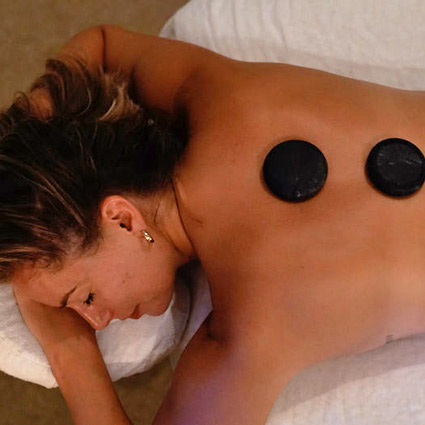Massage Therapy at Deerfield Health & Wellness

What is Massage Therapy?
Massage is a “hands-on” therapy in which muscles and other soft tissues of the body are manipulated to improve health and well-being. Varieties of massage range from gentle stroking and kneading of muscles and other soft tissues to deeper manual techniques.
Massage has been practiced as a healing therapy for centuries in nearly every culture around the world. It helps relieve muscle tension, reduce stress, and evoke feelings of calmness. Massage affects the body as a whole, specifically influencing the activity of the musculoskeletal, circulatory and lymphatic systems.
MAKE AN APPOINTMENT

-
Between Anna Lisa’s deep tissue massage and Dr Ryan’s adjustments……… feeling 10 times better than I did when I walked in! THANK YOU!
-Denise G.
-
From making the initial appointment to finishing and walking out, I had hands down the best guidance, customer service and Sarah was so very friendly and helpful. Stacey my massage therapist did a fantastic job and certainly helped me reset my body and mind, I have already made a second appointment for mid March and I am very much so looking forward to it. 10/10
-Anthony L.
-
I enjoyed my massage and will be back.
-Linda J.
-
Great massage!
-Joseph N.
-
My first massage experience was great! I really enjoyed the explanation of different chiropractic services and I was reassured that any issues I had with my joints and muscles could be addressed.
-Randall E.
-
It was one of the best massages I’ve ever had. I do not live in the area any longer. I was visiting and was given the massage as a gift. I Have already told friends and family if they are considering a massage they should go to your office.
-Terri G.
-
Ed was wonderful and Celia was warm and cheerful.
-Sally P.
Types of Massages
There are nearly 100 different massage and body work techniques. Each technique is uniquely designed to achieve a specific goal. The most common types practiced in the United States include:
Massage FAQs
What is the History of Massage?
The use of massage for healing purposes dates back 4,000 years in Chinese medical literature and continues to be an important aspect of Traditional Chinese Medicine (TCM) today. A contemporary form of massage known as Swedish massage was introduced to the United States in the 1850s. By the end of the 19th century, a significant number of American doctors were practicing this massage technique and the nation's first massage therapy clinics opened its doors to the public. In the early 20th century, the rise of technology and prescription drugs began to overshadow massage therapy. For the next several decades, massage remained dormant and only a few therapists continued to practice the "ancient" technique. During the 1970s, however, both the general public as well as the medical profession began to take notice of alternative medicine and mind-body therapies, which thrust massage therapy back into the limelight. Today, there are more than 125,000 massage therapists practicing in the United States and their numbers are growing rapidly to keep up with the more than 80 million massage therapy appointments made every year.
How does massage work?
When a practitioner massages soft tissue, electrical signals are transmitted both to the local area and throughout the body. These signals help heal damaged muscle, stimulate circulation, clear waste products via the lymphatic system, boost the activity of the immune system, reduce pain and tension, and induce a calming effect. They may also enhance a general sense of well-being by stimulating the release of endorphins (natural pain-killers and mood elevators) and reducing levels of certain stress hormones.
What happens during a massage therapy session?
At your first massage therapy session, the practitioner will ask you about any symptoms you may have (like low back pain) and will also ask questions about your medical history. The practitioner may also initiate a discussion about what you expect to achieve from the massage session. The therapist leaves the room while you undress and lay down on the massage table. A sheet is used as a drape during the session and is moved only to expose the part of the body being worked on at any given time. Massage oil or lotion is often used to reduce friction between the practitioner's hands and your skin. The room is kept warm and free of distractions. The therapist may have soft music playing in the background and frequently asks whether he or she is applying too much or too little pressure. The manner in which a practitioner massages your body depends on the problem being treated. A massage session can last from 15 to 90 minutes and may include a schedule of follow-up visits, depending on the severity of your situation.
What is massage good for?
In general, massage is believed to support healing, boost energy, reduce recovery time after an injury, ease pain, and enhance relaxation, mood, and well-being. In addition to being of value for many musculoskeletal problems such as low back pain, osteoarthritis, fibromyalgia, and sprains and strains, massage may relieve depression in people with chronic fatigue syndrome, ease chronic constipation (when the technique is performed in the abdominal area), decrease swelling after a mastectomy (removal of the breast), alleviate sleep disorders, and improve self-image. In the workplace, massage has been shown to melt away stress and enhance mental alertness. Studies have found that massage relieves chronic back pain more effectively than other treatments (including acupuncture and conventional medical care for this condition with education via books and videos) and, in many cases, costs less than other treatments for this common health problem. In addition, mothers and newborns also appear to benefit from massage. Mothers trained to massage their infants often feel less depressed and have a better emotional bond with their babies. Newborns who receive massage from their mothers also tend to cry less, and are more active, alert, and sociable. Premature babies who receive massage therapy have been shown to gain weight faster than preemies who do not receive this type of therapy. Infants who receive massage regularly may also sleep better, be less gassy or colicky, and have better body awareness as well as more regular digestion.
Studies have also shown that massage may be an effective treatment for young children and adolescents with a wide range of health problems including the following:
Autism: Autistic children, who usually don't like being touched, show less autistic behavior and are more social and attentive after receiving massage therapy from their parents.
Atopic dermatitis/Eczema: Children with this scaly, itchy skin problem seem to experience less redness, scaling, and other symptoms if receiving massage between flares. Massage should not be used when this skin condition is actively inflamed.
Attention deficit hyperactivity disorder (ADHD): Massage may improve mood in children with ADHD and help them feel less fidgety and hyperactive.
Bulimia: Studies have shown that adolescents with this eating disorder feel less depressed and anxious after receiving massagetherapy. Cystic fibrosis: Massage may reduce anxiety and improve respiration in children with this lung condition.
Diabetes: Massagemay help regulate blood sugar levels and reduce anxiety and depression in children with diabetes.
HIV: In a small study, teenagers with the human immunodeficiency virus (HIV) showed improved immune function and diminished feelings of depression and anxiety after receiving two massages per week for 12 weeks. Rheumatoid arthritis: Children with juvenile rheumatoid arthritis (JRA) have been shown to experience less pain, morning stiffness, and anxiety as a result of massage therapy.
Are there any risks associated with massage?
In general, massage is considered relatively safe. Pain or other rare negative side effects are generally caused by an extremely vigorous massage technique. Women should be very cautious about receiving massages during pregnancy. If you are pregnant, be sure to find a therapist specifically trained to perform massages on pregnant women. Even though massage is a useful technique to help regulate blood sugar over time, if you have diabetes you should check your blood sugar after a massage session because it may be too low just following a treatment. Plus, if you have diabetes and you are receiving massage on a regular basis, you should check your blood sugar frequently to evaluate for any changes over time.
Should anyone avoid massage?
Massage should be avoided by people with congestive heart failure, kidney failure, infection of the superficial veins (called phlebitis) or soft tissue (called cellulitis) in the legs or elsewhere, blood clots in the legs, bleeding disorders, and contagious skin conditions. If you have cancer, you must check with your doctor before considering massage because you should not receive such treatments under certain circumstances. For example, sometimes massage can damage tissue that is fragile from chemotherapy or radiation treatments. People with rheumatoid arthritis, goiter (a thyroid disorder characterized by an enlarged thyroid), eczema and other skin lesions should not receive massage therapy during flare-ups. Experts also advise that people with osteoporosis, high fever, few platelets or white blood cells, and mental impairment, as well as those recovering from surgery, may be better off avoiding massage. Also, be sure to let your massage therapist know any medications you are taking as the treatment may influence absorption or activity of both oral and topical medications.
What is the future of massage?
More research is needed to determine how effective massage therapy is, which health problems improve the most from this technique, and whether it is more cost-effective than other types of treatment. Although massage is usually offered in the community by private practitioners, it is slowly being integrated into a variety of healthcare settings, such as hospice care facilities and hospitals.
Schedule an Appointment
Ready to make an appointment? Give our Deerfield Beach office a call today.
CONTACT US
Massage Therapy Deerfield Beach FL | (954) 570-4080



